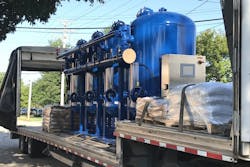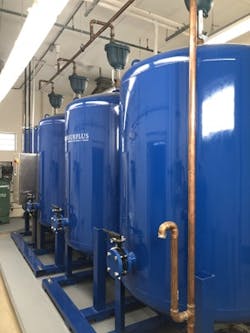Use of High-Loading-Rate Catalytic Filter Media Improves Contaminant Removal
In 2005, the town of Greenville, Wis., realized that arsenic in its water required treatment when the arsenic limit was to be lowered to 10 µg/L in 2007. The town applied for and was granted funding through the U.S. EPA demonstration site program for a federally funded treatment project. Prior to the water treatment plant installation, well modifications lowered the arsenic to below the revised maximum contaminant level (MCL) but resulted in higher radium than the new MCL requirement of 5 picocurie (pCi) per liter combined Ra226 and Ra228.
The original filter design used ceramic filter media and fiberglass-reinforced plastic vessels for iron and arsenic removal. Since arsenic was no longer an issue and the radium level increased, Greenville added a hydrous manganese oxide (HMO) feed for radium adsorption and filtration. Chlorine oxidized the 1.2 mg/L of iron, which made it easier to filter out. Run times were only two hours or so before backwash was required, making the yield from the treatment process very poor—around 50% with a production of 35,000 gal between backwashes.
The Solution
Jim Groose from Watersurplus suggested using the high-loading-rate catalytic OxiPlus75 filter media for removal of iron, manganese and radium. The town’s engineering firm, CBS2, recommended a pilot test to demonstrate the process for approval by the Wisconsin Department of Natural Resources. Run times over 12 hours of operation at a loading rate of 6.3 gal per minute (gpm) per sq ft were successfully demonstrated by that pilot test and were approved by the state.
A four-vessel, 54-in.-diameter vessel, pre-piped and prewired skid-mounted system was determined to be the proper system for a flow of 400 gpm from Well #2. This groundwater treatment equipment was installed in June 2017. Run times of 14 to 15 hours before backwash were achieved—a greater than 95% yield. The groundwater went from 1.2 mg/L of iron to 0.02 mg/L iron—a greater than a 98% removal efficiency. Chlorination prior to the catalytic filter allows the catalytic properties of the OxiPlus75 to oxidize any iron, manganese and hydrogen sulfide prior to completion of filtration.
The Results
The HMO addition was 0.4 mg/L and achieved a reduction of combined radium from 7.6 pCi per liter, above the MCL of 5.0 pCi per liter, down to 1.12 pCi per liter. The treated water manganese also was lowered from the inlet of 0.40 mg/L with the addition of HMO down to 0.02 mg/L after filtration. The new OxiPlus75 treatment system achieves a significantly improved production of 350,000 gal between backwashes with high-quality water below the MCL for radium and below the secondary MCLs for iron and manganese.

